Last updated on March 11th, 2023 at 08:09 am
Introduction
With the increasing acceptance of cryptocurrencies by various countries, newer ways to earn through Cryptocurrencies are being discovered. One such way is the Staking of cryptocurrencies. Staking is one of the most widely used modes of earning rewards. A user can stake cryptocurrencies in wallets to earn more cryptocurrencies.
For instance, let’s take the example of traditional Banking. Whenever you deposit money in your Savings account the Bank pays interest to you on your money. Likewise, by depositing cryptocurrencies in certain wallets (which we will discuss shortly) you can earn rewards. Hence, the interest that you receive from Banks is comparable to the reward that you receive while Staking.
- What is Staking of Cryptocurrencies?
- How does Staking of Cryptocurrencies work?
- How to start staking of Cryptocurrencies? Where can I stake my Cryptocurrency?
- How are my Staking rewards calculated?
- What is a Staking pool?
- What are the advantages & disadvantages of Staking of Cryptocurrencies?
- Popular coins that can be staked
- Bottom Line
What is Staking of Cryptocurrencies?
Cryptocurrency Staking is the process of ‘holding’ your crypto assets in a wallet in order to get rewards. Staking is a low resource-intensive process that supports the security and operations of the blockchain network. Nodes or users use Staking to validate transactions and create new blocks which form part of the Blockchain.
Normally, you can stake your cryptocurrencies in:
- Digital online Wallets like
- Trust Wallet,
- Atomic Wallet etc.
- Hardware Wallets (Cold Staking) like
- Cryptocurrency exchanges (Staking Pools) like
- Enterprises Staking Platforms (Staking as a Service) like
- Stake Capital,
- Staked,
- MyContainer etc
You can use our guide on Best Staking Wallets to choose a wallet for staking your cryptocurrency.
In order to head forward, let’s first understand what Proof of Work (PoW) and Proof of Stake (PoS) mean.
Proof of Work (PoW)
We all know, Bitcoin is the first and the most famous Cryptocurrency. The protocol on which Bitcoin operates is termed as ‘Proof of Work‘ (PoW). PoW helps Bitcoin’s network to allow transactions to gather in the form of blocks. Further, participants (i.e. ‘miners‘) are required to solve a complex mathematical puzzle to validate these transactions. The miner who solves the problem i.e. ‘works on it’ first gets the right to add the next block.
Hence, the work of such a miner helps validate transactions on the network. Further, Every successful miner gets a reward.
PoW is a robust process for achieving validation on Bitcoin’s blockchain but it requires a lot of computational power and electricity. Certainly, this high amount of energy utilized in solving a mathematical puzzle for keeping the network secured is not justified.
This is when the developers started searching for more energy-efficient ways of validation. And they finally came up with Proof of Stake. Proof of Stake (PoS) helps to overcome this shortcoming of Bitcoin’s protocol.
Proof of Stake(PoS)
The underlying concept of PoS is that participants lock their cryptoassets to form a consensus. The assets are locked in form of nodes. At each time interval, the network randomly selects a specific node. After the selection of the node, the network assigns it, rights to validate the next block. Generally, the probability on which the network selects nodes is proportional to the number of coins held i.e staked with the node. A node that holds more coins will get more rewards.
Accordingly, in order to create a new block, a participant is required to lock (or stake) more crypto assets (PoS). In contrast to, solving complex Hash problems in PoW.
Further, in the case of PoW, scalability also becomes a problem due to the need for high computational power. For example, Ethereum’s original blockchain was managed using PoW processing. It is now migrating to PoS processing collectively termed ‘ETH 2.0′.
How does Staking of Cryptocurrencies work?
PoW requires the use of specialized mining hardware like ‘ASICs‘. These ASICs are used to solve complex hashes as we discussed earlier. The process of mining validates existing blocks and creates new blocks. However, in the case of PoS, the blocks are created by validating old blocks through Staking. In a nutshell, what mining does in the case of PoW, staking does in the case of PoS.
Staking enable anyone to perform validation on the blockchain for suitable rewards.
Based on the time period of holding cryptocurrency, Staking can have different types. These are:
- Fixed staking and;
- Flexible staking
Due to the rigidity of locking cryptocurrency, rewards in the case of fixed staking are more than flexible staking. These rewards reduce drastically if coins are withdrawn before the agreed time period.
How to start staking of Cryptocurrencies? Where can I stake my Cryptocurrency?
Though Staking of coins may sound very technical, in reality, it is not. The complexity depends on the mode you want to use to stake your coins. Consequently, your coins can be staked using independent Wallets or exchanges. The procedure for Staking is enumerated below:
Step 1 – Buying PoS cryptocurrency
You can buy your PoS Cryptocurrency from the cryptocurrency’s respective website, various wallets or from Exchanges like
There are a number of PoS cryptocurrencies that can be staked like ETH 2.0, Cardano, Pancakeswap, Mina etc. We will be discussing them in more detail later in the post.
Step 2 – Staking
Once you have bought your cryptocurrency. It is time to stake it and earn rewards. Staking can be done through:
- Digital wallets like Trust Wallet, Atomic Wallet etc: In this case, the procedure of staking is a little tedious but worth the effort. Trust Wallet App has support for the staking of several currencies. Most DeFi cryptocurrencies have their own websites where you can connect your wallet and stake.
For Example, Alpaca Finance, Harvest Finance can be staked at their respective websites. Moreover, there are many Staking as a Solutions (SaaS) websites like that Stake Capital, Staked, MyContainer etc where you can stake your coins.
Please make sure that you undertake proper due diligence of the platform before staking your coins.
Cold staking using Hardware Wallets like Ledger, Trezor and Stakebox. These wallets are not permanently connected to the internet and hence are the safest option to stake your cryptocurrency. Ledger offers staking for Tezos, Tron, Cosmos, Algorand, Polkadot.
Trezor requires pairing with third-party apps like Exodus which offers staking for Algorand, Cardano, Cosmos, NEO/GAS, ONT/ONG, Solana, Tezos, VET/VTHO. Further, Stakebox offers staking for stakebox is available for QTUM, Reddcoin, Neblio, Cloakcoin, Peercoin, PIVX, PinkPi, Pokos, Whitecoin, Denarius, Bitbay and Trezarcoin. Please go through our mammoth article on best staking wallets to stake your cryptocurrencies to know more
Exchanges like Binance, KuCoin & BitFinex also offer Staking services. For new investors, exchanges like these are a safer option compared to open platforms. Further, such websites have their own Staking pools where chances of getting higher rewards are easier. Let’s understand how staking works at Binance.
How to stake your coins at Binance?
Staking at Binance is very easy because all the technical work is taken care of by Binance. As a result, you have to just select your cryptocurrency and put it for staking.
Firstly, you have to create an account on Binance.
Secondly, login into your Binance account and purchase the cryptocurrency of your interest. There is a whole list of cryptocurrencies that can be staked on Binance like ETH 2.0, Cardano (ADA), Solana, Farm, FET, Alpha etc. Please note that it is mandatory for you to complete your KYC with Binance before purchasing any cryptocurrency.
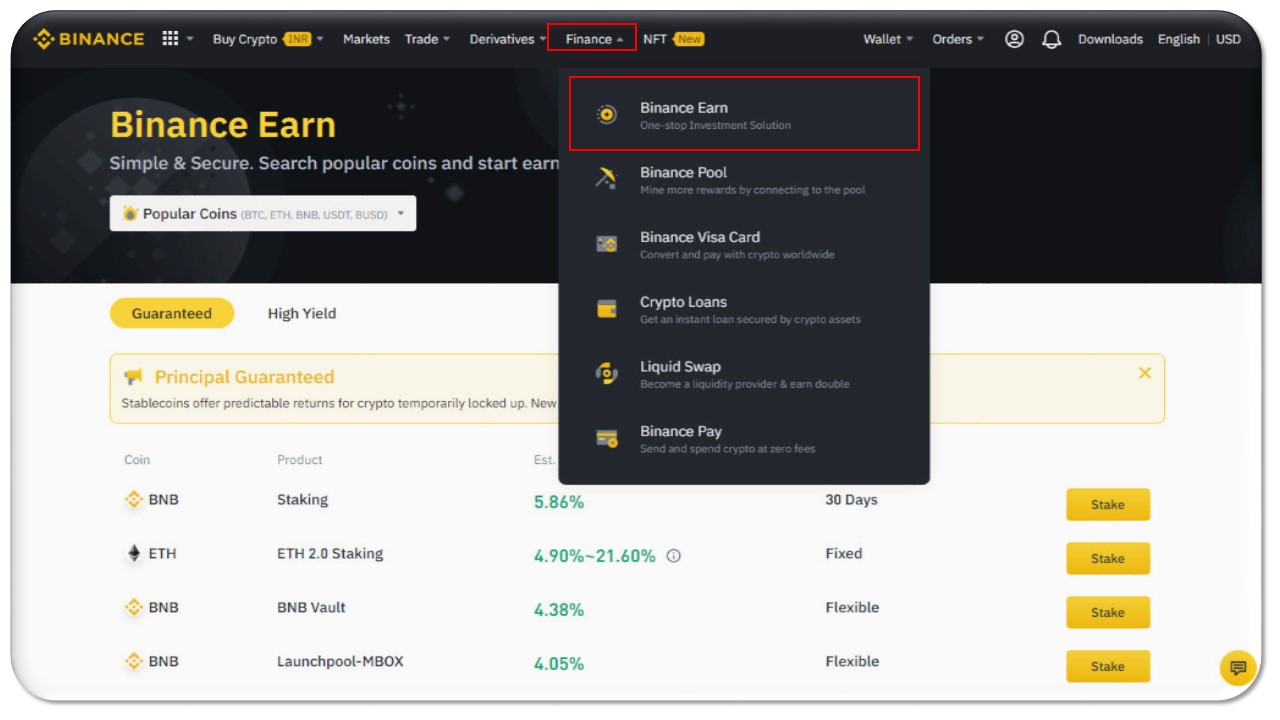
Next, in the top menu go to Finance > Binance Earn.
This page shows all the Flexible Staking options available in Binance. You can stake coins like ETH 2.0, BNB here by clicking on the “Stake” button.
Normally flexible staking options carry lower rewards as we discussed earlier.
However, if you want to stake your assets at higher rewards you need to scroll down this page and reach the “Locked Staking” tab.
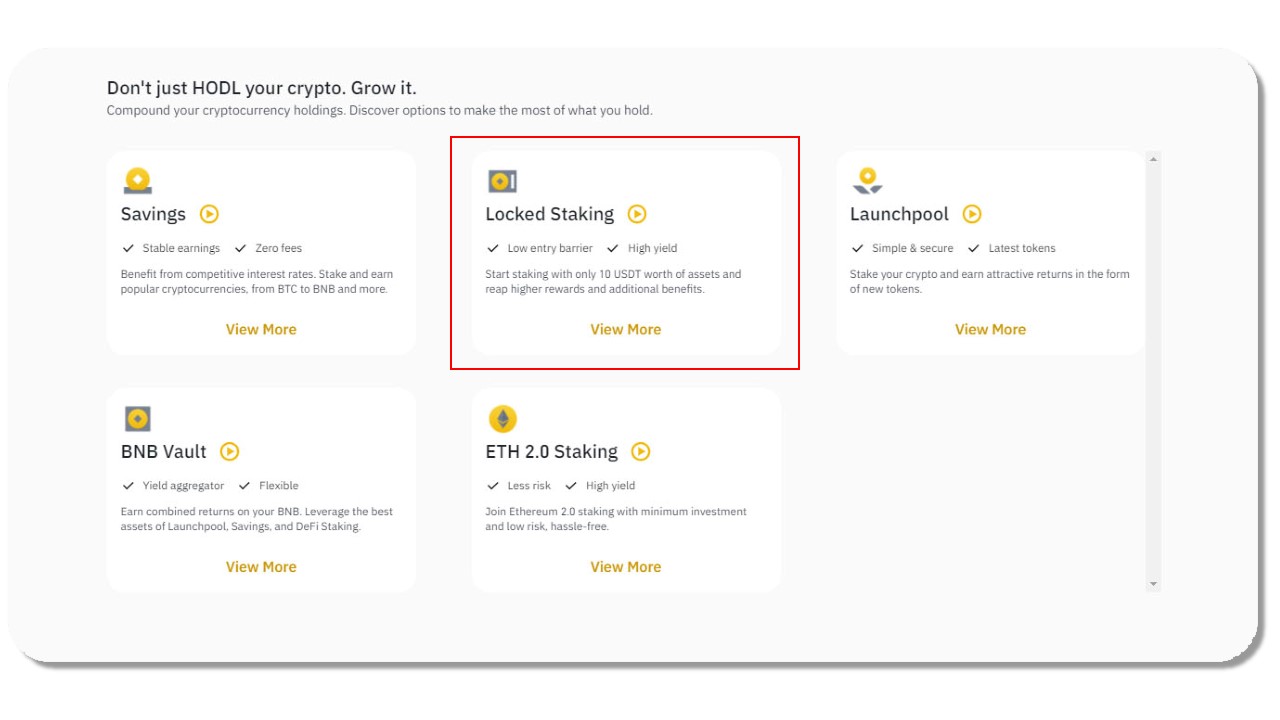
Once you click on the Locked staking tab you would be able to see all the fixed staking options available at Binance for various cryptocurrencies. You can search your cryptocurrency and simply click on the “Stake Now” button to go to the next step.
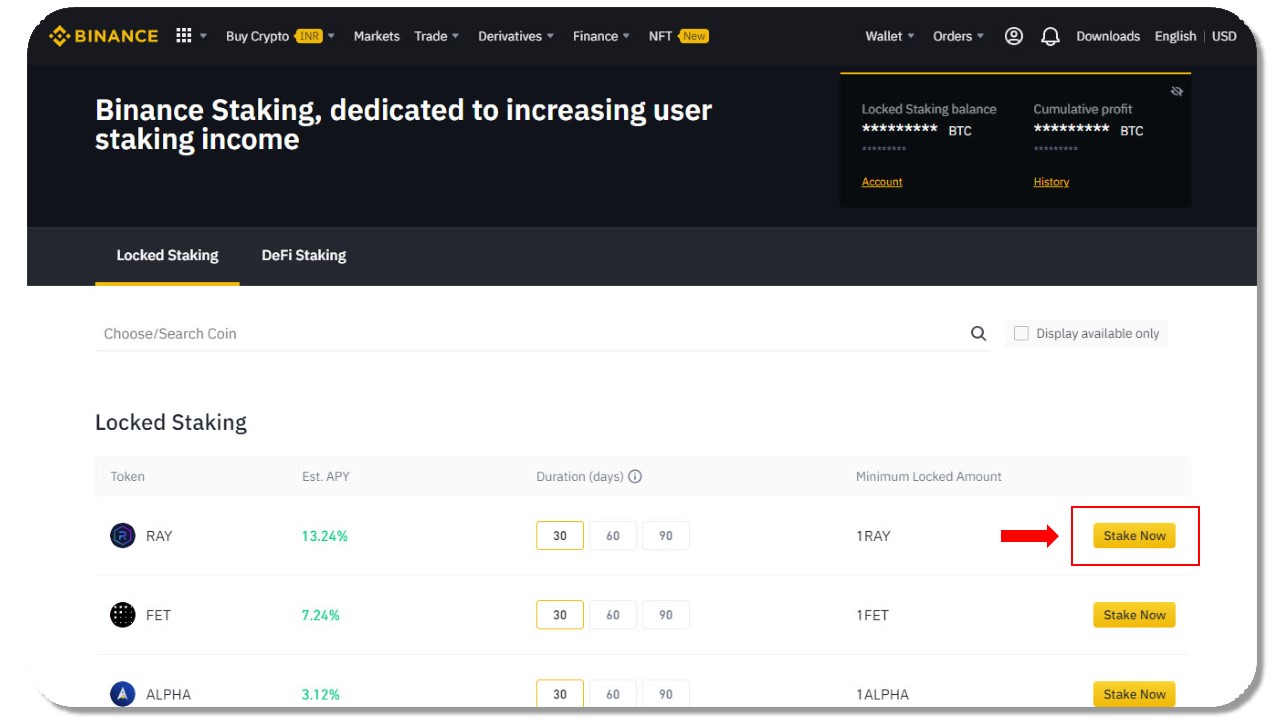
Locked Staking Options
Wait for a pop-up window to open. This window will display various staking options for your cryptocurrency (we selected RAY) like
1. Duration of locking,
2. Amount of currency you would like to stake, Stake date, Value date, Interest period and Estimated APY. Estimated APY or Estimated Annual Percentage Yield is the annual reward that you can expect while staking your cryptocurrency.
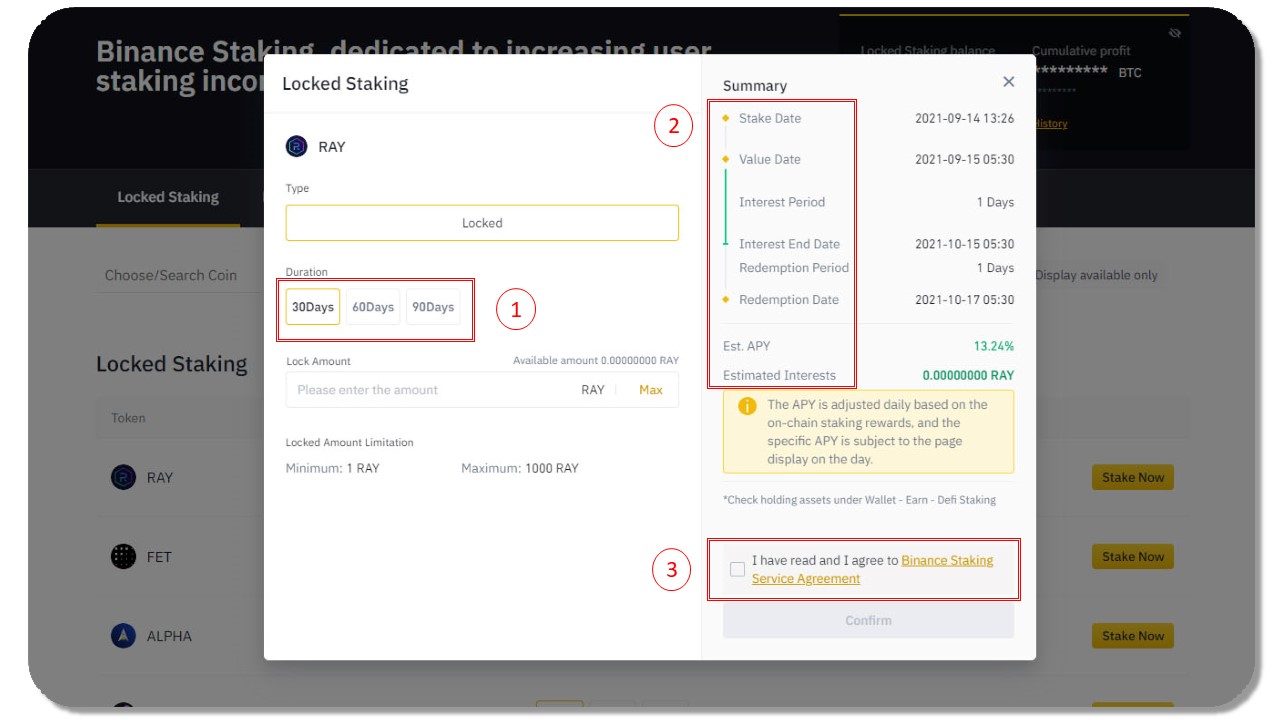
3. Now, you need to select desirable options, accept the Terms of Binance staking and Voila! Your cryptocurrency is now staked.
You can also Stake DeFi coins on Binance by clicking on “DeFi Staking Tab”.
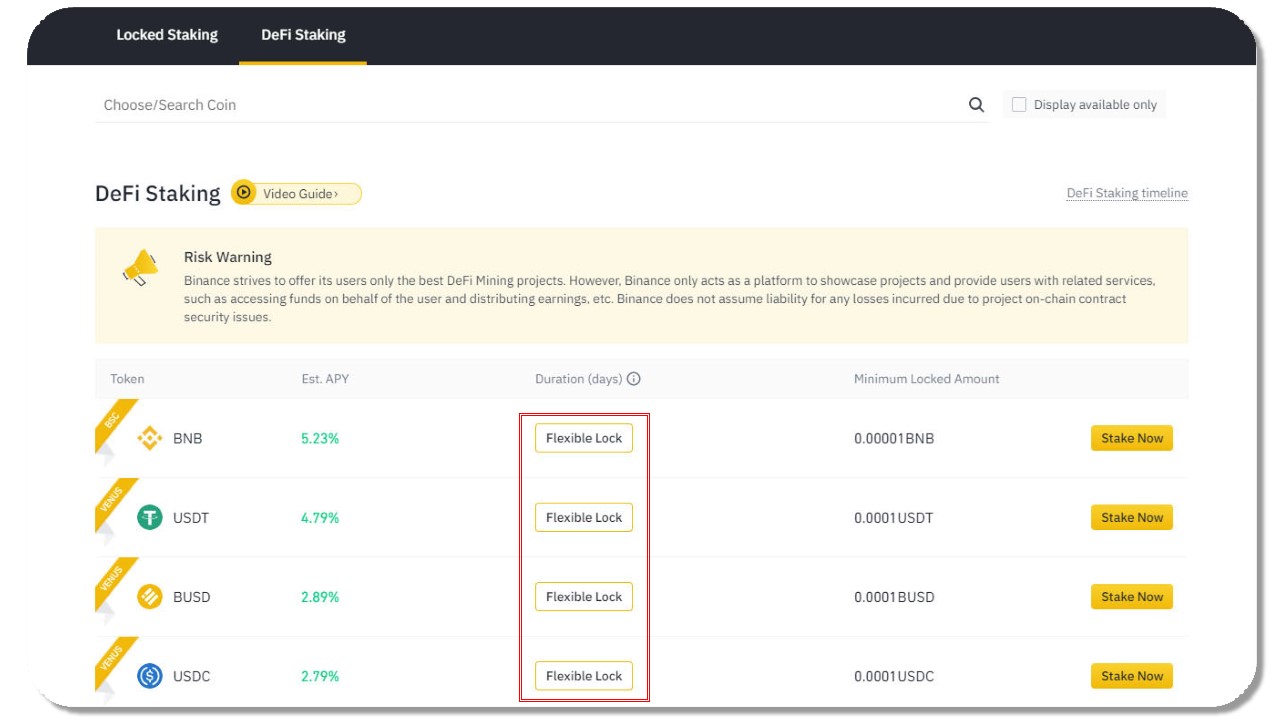
To view your Cryptocurrency after staking you can go to your Wallet on the top right side and click on EARN.
How are my Staking rewards calculated?
In the case of PoS processing networks, there are a number of factors that influence the calculation of rewards. We know that the primary reason for the selection of a validation node by the network is the amount of cryptocurrency held by the node. However, when it comes to the distribution of these rewards there are several factors that come into play like
- Stakeholding of the node
- Degree of active participation of the node
- Time for which the node is staking
- Inflation index
- Uptime of the node
- Other factors
What is a Staking pool?
The amount of cryptocurrency that a node holds determines its selection for forming consensus in the case of Proof of Stake processing. Consequently, the higher the amount of cryptocurrency a node holds higher are the chances of its selection for validation and likewise would be the probability of getting a reward.
Meanwhile, for small investors like us, the ability to hold cryptocurrencies is minuscule when compared to the Whales of cryptocurrencies. I know it sounds pretty sad. Don’t worry!
This is where Staking Pools come to our rescue. Many platforms like Binance, Kucoin, BitFinex have dedicated staking pools where investors like us can pool our cryptocurrency to earn attractive rewards. The process of staking with these platforms is pretty user friendly compared to standalone digital wallets.
These platforms run staking pools for different cryptocurrencies. You can simply select an appropriate pool and stake your cryptocurrency into that pool. We have already discussed how you can participate in Staking Pools in Binance.
The upside of such Staking pools is that the network considers each of these platforms as a single node for validation. Hence, your chances of getting a fantastic reward on your cryptocurrency become multifold even with a smaller investment
What are the advantages & disadvantages of Staking of Cryptocurrencies?
Cryptocurrency staking has gained phenomenal popularity lately due to the underlying rewards for users. However, just like any other technology out there, Staking comes with its own advantages and disadvantages.
Benefits of Staking (Image)
- Generation of Passive Income
- Basic investment in Hardware
- Relatively Energy Efficient
- No prior knowledge on solving hashes is required
Shortcomings of Staking
The high returns of Staking of cryptocurrency come with high risks.
- Security: When you stake your coins in Wallets or other platforms they are prone to cybersecurity risks. Hackers can access and steal from wallets or exchanges. That is why some users keep their coins in Hardware wallets like Ledger, Trezor, StakeBox to name a few. This method of protecting and staking your cryptocurrency is often known as ‘Cold staking’.
What is Cold Storing/Cold Staking? Cold staking is the process of holding your cryptocurrency in a Hardware or air-gapped wallet. These wallets are not connected to the internet thereby reducing the chances of cyber-thefts. Large stakeholders prefer storing their cryptocurrencies in this manner so they can support the network while ensuring maximum protection of their assets. - Downturns in the price of Cryptocurrencies: Another risk of staking cryptocurrencies is a downturn in their prices while they are being held. In the normal scenario, you would sell your coins off if you anticipate a fall in the prices. Staking of your coins acts as a barrier in selling them off.
- Downtime of Validator Node: We discussed in the case of PoS that the network automatically selects nodes to validate transactions. Accordingly, suitable rewards are associated with the validation of transactions. If any of these nodes go down it will result in loss of probability in the selection of nodes by the network. Therefore, there will be lower rewards.
Popular coins that can be staked
Due to the advantages of Proof of Stake processing over Proof of Work, a lot of cryptocurrencies are now made over the PoS network. In fact, high utility cryptocurrency like Ethereum is also transitioning to PoS network.
I would suggest you Do Your Own Research(DYOR) before staking any of your cryptocurrencies. Something that has worked for me may not work for you. Having said that, let’s take a look at some of the well-established cryptocurrencies in the market. These are:
- ETH 2.0
- Cardano,
- Polkadot,
- Polygon,
- Kusama,
- Solana,
- Algorand
This is a non-exhaustive list. To clarify, different cryptocurrencies yield different staking rewards. This gives you ample options while selecting the coin for staking.
Bottom Line
In conclusion, it is evident that staking has its downsides when it comes to vulnerability to cyber threats and the probable diminishing value of cryptocurrency. However, these are small hurdles compared to the rewards which you can expect.
Most importantly, staking provides rewards on your otherwise idle cryptocurrency. Staking is particularly beneficial for long term investors. It is beyond a doubt that staking of cryptocurrencies is a highly effective and safe mode of earning cryptocurrencies.


